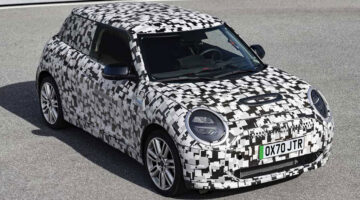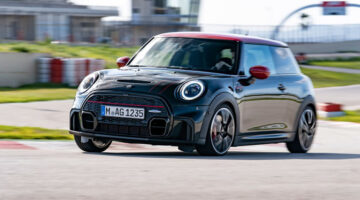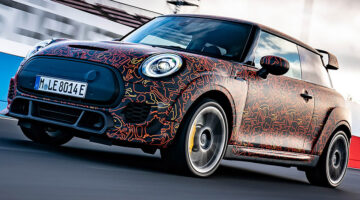crankandpiston takes the new John Cooper Works Paceman for a spin in Dubai, UAE, to find out what the seventh addition to MINI’s line-up brings to the party.
[Not a valid template]Last September’s unveil of the ‘long-awaited’ seventh addition to the MINI line-up – the Paceman – didn’t click many people’s tickers into overdrive. At the time the company boasted not one but two convertible models (the Convertible and the Roadster), an estate wagon (the Clubman), a Coupe, and a 4×4 model (the Countryman) as well as its long established Cooper. Indeed, for more than three decades, Mini – as it then was – survived happily off its eponymous city car. Even when the BMW Group took the reigns in 2001, few of its customers were clamouring for a new Sports Activity Coupe to join the line-up.
Though questionable, the principle was at least straightforward, drawing more than a little inspiration from its big BMW brother, the X6: an SUV in body but with Coupé-esque styling and punch. It’s a punch that’s been further emphasised thanks to the recently launched John Cooper Works version, an über dynamic model in homage to John Cooper, father of the Cooper. Since our curiosity has spoken sufficient volumes over the last twelve months, we figured now was as good a time as any to take the Paceman for a spin.
What does surprise me to start with is the size: although a MINI, the JCW Paceman still stands 1527mm tall, higher than a Ford Focus. In the flesh though the JCW does look pretty good. The front end is perhaps a little bulbous and ungainly, but the swoop of the roofline – offset nicely by the traditional JCW red roof and grey paintwork – is actually pretty slick. So too are the exclusive 18-inch light alloy wheels. A word of warning though: the spokes concave out, meaning kerbing a wheel seems an inevitability.
In the cabin we have the traditional MINI ‘wackiness’ including the big centre-mounted speedometer (though with a digital readout available behind the steering wheel, you’ll rarely feel the need to use it), the superbly delicate rotary dial for the MINI Connected infotainment system, and the retro-style switches for the windows and central locking. The Paceman also boasts a Lounge Concept, which essentially means the rear bench has been ripped out and replaced with two separate seats. They certainly offer good support but there’s less room than you’d expect given the car’s size. One feature I find pretty tricky is the handbrake, which looks like it’s been swiped from a Soviet tank. Ridiculous but zany; I like it.
Much like its Paceman base model, the JCW boasts a 1.6-litre twin-turbocharged flat-six under the bonnet, which punches out 218hp (96hp more than the Paceman) and 207lb ft of torque (99lb ft more). There’s also newly upgraded chassis and suspension, which includes stiffer dampers, firmer suspension springs and anti-roll bars, a lower ride height as a result, and presumably a more balanced drive.
There’s no denying that. Despite a high(ish) centre of gravity, there’s remarkably little body roll through the tight corners even if, since I’m sitting higher than I’d ideally like, it feels a little more aggressive from the driver’s seat. Grip through the front wheels is also impressive, sufficient feel through the steering wheel allowing you to put the front wheels where you want them. Something which – sceptically – I hadn’t thought I’d be able to in the 1475kg Paceman. I must admit though that the enthusiasm of the cornering is shadowed by the voice in the back of my mind telling me I’m throwing (essentially) an SUV through the corners ad hoc. For an SUV, it’s very impressive. For a MINI, it seems a step in the wrong direction.
What really impresses is the gutsy 1.6-litre unit, from which power is distributed evenly through all four wheels (only the second MINI to do so after the Countryman). Off the line you’ll hit 100kph in just 6.9 seconds and motor onto a 226kph top speed. Acceleration is impressive, aided by an influx of torque between 2100-4500rpm via the overboost function. It’s a system that opens the taps on the sports exhaust system, injecting (temporarily) an additional 14lb ft of torque into the mix.
Flick the Sport switch on the centre console and a remapped engine for faster throttle response (as well as an audible burble on the overrun), and the turbo kick is very noticeable. The effect wears off the closer you get to the redline, but it’s a serious thump of power delivered all at once. Take a few moments to get your head around the gearshift rocker setup – whereby you can press either paddle forward to upshift and pull either paddle back to downshift – on the steering wheel and you should soon be really motoring. Braking thankfully is taken care of almost as quickly, with newer, larger callipers (that have been painted red for differentiation) that offers just enough travel in the pedal to keep you connected. And again, for an SUV it’s very impressive. But for a MINI, it all feels a little heavy.
The MINI John Cooper Works Paceman is surprisingly nimble when it needs to be, and the enthusiasm under acceleration is an eye-opener in itself. To me though the joie de vivre of a MINI coupe can’t quite overhaul the practicalities of a MINI SUV: it’s just too tempting to drive the Paceman like a coupe rather than like an SUV, and while to an extent you can, it doesn’t quite give the same buzz.
There’s also the small matter of the price. At a hefty $55,813 you’re approaching BMW 3 Series money. There is something you really could call practical and sporty.
Oh, and if you’re wondering about the pictures at the top, remember that MINI’s new marketing campaign is ‘NOT NORMAL’. Happy to oblige.
– FULL GALLERY OF SHOTS AVAILABLE HERE – CLICK –
| MINI | John Cooper Works Paceman | |
|---|---|---|
| Engine: | Inline 4-cyl / 1598cc | |
| Power: | 218hp @ 600rpm | |
| Torque: | 207lb ft @ 1900-5000rpm (221lb ft @ 2100-4500rpm) | |
| Transmission: | Six-speed automatic transmission | |
| Front suspension: | Single-joint MacPherson spring-strut axle with anti-dive control | |
| Rear suspension: | Multi-link axle with aluminium longitudinal struts and centrally pivoted control arms | |
| Brakes: | Vented discs / 307mm × 24mm (front) / 296mm × 10mm (rear) | |
| Wheels: | 7.5J × 18 light-alloy front and rear | |
| Tyres: | 225/45 R18 front and rear | |
| Weight (kerb) | 1495kg | |
| 0-100kph: | 6.9sec | |
| Top speed: | 226kph | |
| Price: | $55,813 |



